
Bicycle stand
Encyclopedia
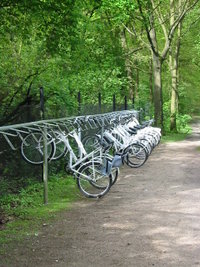
also called a bike rack, is a device to which bicycles may be securely attached. It may be free standing or securely attached to the ground or some stationary object such as a building. Indoor bike racks are commonly used for private bicycle parking, while outdoor bike racks are often used in commercial areas. General styles of racks include the Inverted U, Serpentine, Bollard
Bollard
A bollard is a short vertical post. Originally it meant a post used on a ship or a quay, principally for mooring. The word now also describes a variety of structures to control or direct road traffic, such as posts arranged in a line to obstruct the passage of motor vehicles...
, Grid, & Decorative. The most effective and secure bike racks, with the exception of the bike locker, are those that can secure both wheel and frame of the bicycle, using a standard U-lock or cable.
Bike racks can be constructed from a number of different materials. Durability, weather resistance, appearance, and functionality are extremely important variables of the material of the bike rack. Construction materials include stainless steel
Stainless steel
In metallurgy, stainless steel, also known as inox steel or inox from French "inoxydable", is defined as a steel alloy with a minimum of 10.5 or 11% chromium content by mass....
, steel
Steel
Steel is an alloy that consists mostly of iron and has a carbon content between 0.2% and 2.1% by weight, depending on the grade. Carbon is the most common alloying material for iron, but various other alloying elements are used, such as manganese, chromium, vanadium, and tungsten...
, recycled plastic, or thermoplastic
Thermoplastic
Thermoplastic, also known as a thermosoftening plastic, is a polymer that turns to a liquid when heated and freezes to a very glassy state when cooled sufficiently...
. Each material has advantages and disadvantages, and each is unique in appearance from the others.
The visibility of the bike rack, adequate spacing from automobile parking and pedestrian traffic, weather coverage, and proximity to destinations are all important factors determining usefulness of a bicycle rack. These factors will help increase usage of the bike rack, and assure cyclists their bike is securely parked.
History
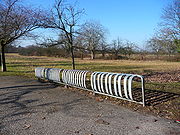
Concrete
Concrete is a composite construction material, composed of cement and other cementitious materials such as fly ash and slag cement, aggregate , water and chemical admixtures.The word concrete comes from the Latin word...
in the ground, a forked piece of metal into which a wheel of the bicycle is pushed, or a horizontal ladder providing positions for the front wheel of many bicycles. These are not very effective, since a thief need only detach the wheel in question from the bicycle to free the rest of the bicycle. They also do not offer much support, and a row of bicycles in this type of stand are susceptible to all being toppled in a domino effect
Domino effect
The domino effect is a chain reaction that occurs when a small change causes a similar change nearby, which then will cause another similar change, and so on in linear sequence. The term is best known as a mechanical effect, and is used as an analogy to a falling row of dominoes...
. These types of stand are known as "wheel benders" among cyclists.
A modern version is known as the "Sheffield rack" or "Sheffield stand", after Sheffield
Sheffield
Sheffield is a city and metropolitan borough of South Yorkshire, England. Its name derives from the River Sheaf, which runs through the city. Historically a part of the West Riding of Yorkshire, and with some of its southern suburbs annexed from Derbyshire, the city has grown from its largely...
in England where these were pioneered. These consist of a thick metal bar or tube bent into the shape of a square arch. The top part is about level with the top bar of the bicycle frame, and thus supports the bicycle and allows the frame to be secured. High-quality versions feature a second, lower horizontal bar to support smaller bikes (this version is also known as “A stand”), and are coated to reduce their surface hardness and not scratch paint.
Since 1984 the City of Toronto
Toronto
Toronto is the provincial capital of Ontario and the largest city in Canada. It is located in Southern Ontario on the northwestern shore of Lake Ontario. A relatively modern city, Toronto's history dates back to the late-18th century, when its land was first purchased by the British monarchy from...
has installed post and ring bicycle racks consisting of a steel post topped by a cast aluminium ring. In August 2006, it became publicly known that these stands could be defeated by prying the ring off with a two-by-four http://www.thestar.com/NASApp/cs/ContentServer?pagename=thestar/Layout/Article_Type1&c=Article&cid=1155678611477&call_pageid=971358637177&col=Columnist1050919322274
In Amsterdam
Amsterdam
Amsterdam is the largest city and the capital of the Netherlands. The current position of Amsterdam as capital city of the Kingdom of the Netherlands is governed by the constitution of August 24, 1815 and its successors. Amsterdam has a population of 783,364 within city limits, an urban population...
two-tiered bicycle stands are ubiquitous. Bikes can be parked in a smaller area as the handlebars
Bicycle handlebar
Bicycle handlebar or often bicycle handlebars refers to the steering mechanism for bicycles; the equivalent of a steering wheel. Besides steering, handlebars also often support a portion of the rider's weight, depending on their riding position, and provide a convenient mounting place for brake...
(usually wider than the back of the bicycle) of every other one is at a different height (either high or low). These racks are made of steel and have a large bar to which the frame may be easily locked. Most Dutch bicycles have a rear wheel lock, so that wheel need not be locked.
Classes
Bike parking needs vary from environment to environment.Class I:
Some locations require Class I standards (commonly referred to as long-term bike parking). Class I parking regulations are implemented when bicycles will be parked for hours at a time. Examples of these environments are office buildings, elementary schools, libraries, etc. When implementing Class I bike racks, installers should also incorporate some form of weather protection for the racks and bikes.
Class II:
More commonly seen in public areas are Class II bike racks. These bike racks are needed when cyclists will be leaving their bikes unattended for less than two hours. Weather protection is not as important for this class, however distance from main attractions should be considered to encourage usage. Class II bike racks can be implemented near fast food restaurants, parks, picnic areas, or other similar places.
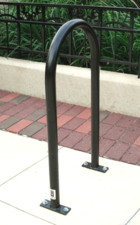
Styles
Many different styles of bike racks are available to match any environment. Specific details such as bolt size, tubing diameter, tubing style (square or round), height, length, and many other things vary with manufacturer, but typically, there are six general styles of commercial bike racks.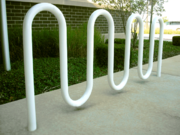
- U-Racks: A simple design, the inverted U Rack is the most basic bike rack present in commercial areas today. It is conveniently used in urban areas because it can be placed along sidewalks without taking too much space away from pedestrians, and also has a clean appearance that blends in well with other urban traffic structures. Also known as: Staple rack
- Wave/Serpentine: The wave design of this bike rack is essentially an extension of the U-Rack. The waves allow for the storage and securing of more bicycles than the single U-Rack, while keeping it simple for bike riders to use. The familiar shape of this bike rack is identifiable to most cyclists, and does not take up a lot of room. However, the serpentine rack only supports a bicycle frame at one point (as opposed to two points with a U-rack), resulting in a greater chance of the bicycle falling over when parked in the rack.
- Bollard Style: BollardBollardA bollard is a short vertical post. Originally it meant a post used on a ship or a quay, principally for mooring. The word now also describes a variety of structures to control or direct road traffic, such as posts arranged in a line to obstruct the passage of motor vehicles...
s are short vertical posts most commonly used as traffic or parking barriers. Bollard style bike racks utilize this function and double its utility by adding one or two arms to secure bikes to. This style rack is beneficial if you’re trying to monitor pedestrian or driving traffic, or if you’re trying to complement an urban aesthetic with other parking signs, barriers, or traffic structures.
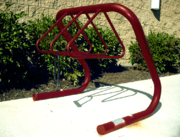
- Grid Style: The fence style bike racks are primarily used for high volume bike storage situations. This style bike rack was more commonly used in the past, and is currently viewed as only appropriate for short-term bike parking where your bike remains in sight at all times. While it is useful in solving space issues, this bike rack does not allow both the wheel and frame of the bike to be locked, allowing for potential theft of the bicycle.
- Innovative: Straying away from conventional bike rack designs, innovative designs incorporate both utility and style into its purpose. Many bike rack engineers have made small alterations to basic bike racks to improve functionality and appearance.
- Decorative: Due to the unique nature of some commercial areas, some environments require a more decorative bike rack. For example, a public aquarium or zoo may prefer a shark shaped bike rack over a traditional style bike rack. While these bike racks may be interesting, it is important to keep in mind security and functionality of these designs.
- Double Deck: Two-tier bike racks can be used to increase bicycle storage capacity in a fixed space. In order to easily maneuver a bicycle onto the top tier, some double deck bike racks incorporate hydraulic pistons to lift the bike into the rack after the user has locked it.
Mounts

- In-ground: The base of the bike rack is planted into the ground, and secured by a perpendicular anchor pin for stability. These stable mounts are most secure from theft or vandalism.
- Surface: FlangeFlangeA flange is an external or internal ridge, or rim , for strength, as the flange of an iron beam such as an I-beam or a T-beam; or for attachment to another object, as the flange on the end of a pipe, steam cylinder, etc., or on the lens mount of a camera; or for a flange of a rail car or tram wheel...
s extending outwards from the base of the bike rack are secured into existing concrete with lag bolts. For added support, surface mounts can also include triangular brackets, also referred to as gusset plateGusset plateGusset plates are thick sheets of steel that are used to connect beams and girders to columns or to connect truss members . A gusset plate can be fastened to a permanent member either by bolts, rivets or welding or a combination of the three . Gusset plates not only serve as a method of joining...
s, to reinforce the connection between the flange and tubing. Surface mounts with this extra support are called gusset mounts. Surface and gusset mounts are used to secure a bike rack into an existing piece of concrete. - Rail mounts: Some bike rack units can be connected with rails. This type allows using single bike racks, while limiting the number of mounts be implemented. Rail mounts are mostly used to connect multiple ‘U’ Racks so each rack need not be mounted, saving labor costs and limiting the number of holes in the surface.
- Wall Mounts: Certain bike racks are designed to be mounted to the wall using bolts to connect flanges of the rack onto existing walls. These conserve floor space and are most useful for long-term storage.
Finishes
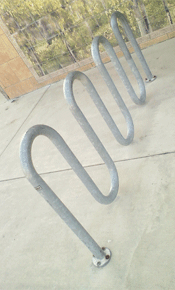
- Galvanized:GalvanizationGalvanization is the process of applying a protective zinc coating to steel or iron, in order to prevent rusting. The term is derived from the name of Italian scientist Luigi Galvani....
Galvanized bike racks are the best value finish. They are inexpensive, and provide a thin layer of zinc for corrosion protection. The appearance is a dull gray color, with little to no shine. - Powder-coat:Powder coatingthumb|right|Aluminium extrusions being powder coatedPowder coating is a type of coating that is applied as a free-flowing, dry powder. The main difference between a conventional liquid paint and a powder coating is that the powder coating does not require a solvent to keep the binder and filler...
This finish is usually available in a wide range of colors. It is achieved by a dry-powder coat that provides a durable outer layer that has a high gloss appearance and excellent weather resistance.

- Thermoplastic-coated:ThermoplasticThermoplastic, also known as a thermosoftening plastic, is a polymer that turns to a liquid when heated and freezes to a very glassy state when cooled sufficiently...
This polyethylenePolyethylenePolyethylene or polythene is the most widely used plastic, with an annual production of approximately 80 million metric tons...
matte finish is usually available in a wide range of colors as well. The powder coating, applied for corrosion protection, can easily match existing surroundings, and creates a finish without runs or drips.. - Recycled Plastic:Plastic recyclingPlastic recycling is the process of recovering scrap or waste plastics and reprocessing the material into useful products, sometimes completely different in form from their original state. For instance, this could mean melting down soft drink bottles and then casting them as plastic chairs and tables...
Recycled plastic bike racks are composed for 96% recycled materials. It does not splinter or crack, is more fire safe than wood, and does not emit harmful chemicals into the environment. - Stainless SteelStainless steelIn metallurgy, stainless steel, also known as inox steel or inox from French "inoxydable", is defined as a steel alloy with a minimum of 10.5 or 11% chromium content by mass....
: Stainless steel is the most durable material for a bike rack. It has maximum corrosion protection, is antimicrobial, and has a glossy appearance that is easy to clean and maintain. - eSteel: The eSteel process produces a durable and uniform finish. The process is environmentally friendly, and is Occupational Safety and Health AdministrationOccupational Safety and Health AdministrationThe United States Occupational Safety and Health Administration is an agency of the United States Department of Labor. It was created by Congress of the United States under the Occupational Safety and Health Act, signed by President Richard M. Nixon, on December 29, 1970...
and U.S. Environmental Protection AgencyUnited States Environmental Protection AgencyThe U.S. Environmental Protection Agency is an agency of the federal government of the United States charged with protecting human health and the environment, by writing and enforcing regulations based on laws passed by Congress...
compliant.
Installation
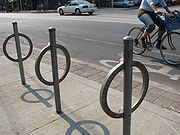
However, while a bike rack should be implemented in a visible area, it is important that the bike rack have adequate spacing away from pedestrians and other traffic. Bike riders will need ample space to maneuver their bike around and into the rack, without hitting other parked bikes, cars, or people. It is also important to place bike racks far enough away from doorways, sidewalks, or paths where it may obstruct traffic flow.
Another important factor to consider is weather protection. If bike racks are being used for long-term parking, the bike rack should be placed under some form of weather protection. This will not only help protect the bike rack from corrosion, but also encourage bike riders to store their bikes there for extended periods of time.
See also
- Bicycle carrierBicycle carrierA bicycle carrier, also commonly called a bike rack, is a device attached to an automobile or bus for transporting bicycles.- By vehicle type :Bus mounted bike carriers are usually attached to the front of the bus...
– a device to transport a bicycle with another vehicle. - Bicycle lockBicycle lockA bicycle lock is a physical security device used on a bicycle to prevent theft. It is generally used to fasten the bicycle to a bicycle stand or other immovable object....
- a device to secure a bicycle to a stand. - Bicycle lockerBicycle lockerA bicycle locker or bike box is a locker / box in which a single bicycle can be placed and locked in. They are usually provided at places where numerous cyclists need bike parking for extended times , yet where the bikes might otherwise get damaged or stolen .Bike boxes are considered the highest...
– a similar device, that offers even more security. - Bicycle parkingBicycle parkingBicycle parking involves the infrastructure and equipment to enable secure and convenient parking of bicycles...
- general topic of parking bicycles. - Bicycle treeBicycle treeA Bicycle tree or cycle tree or bike tree is an bicycle parking system that resembles a tree in shape. There are a few types that have been developed....
- automated bicycle storage device. - Luggage carrierLuggage carrierA luggage carrier, also commonly called a rack, is a device attached to a bicycle to which cargo or panniers can be attached. This is popular with utility bicycles and touring bicycles....
– a device attached to a bicycle to facilitate carrying loads. - Work stand - a tool for holding a bicycle still to facilitate working on it.
External links
- http://www.belson.com/bike-rack-buying-guide.htm
- http://www.bicyclinginfo.org/engineering/parking.cfm
- http://www.vtpi.org/tdm/tdm85.htm
- Japanese robotic multi-story bicycle stand
- Gallery of bike rack styles around the world
- Long term bike rack (vertical parking).

